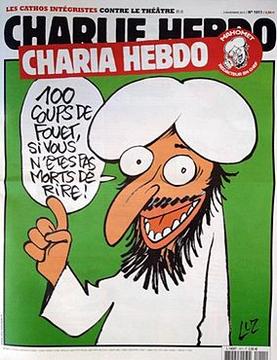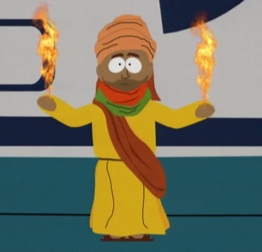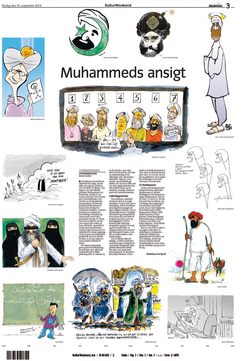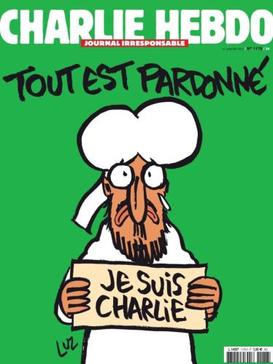Last month, on January 6th, I published in this blog a column entitled, “Chilling Me Softly.” The topic, generally, was about censorship, about the intentional cultivation of censorship as a promotional strategy, and about the the subsequent chilling effect that occurs. I was writing specifically in context of the film The Interview. One paragraph read:
From Joseph Ravens’ penis to the assassination of a baby-faced tyrant, anal fisting to a crucifix in urine, and let’s not forget Our Lady of the Jiggling Butt Cheeks, creative expression invariably steps on some toes. All the sensation created by controversy may bring with it some small benefits in terms of publicity. But if we forget the chilling effect it is to our peril. Even if you don’t care for the current comedy/painting/photograph of a dictator/buttfucking/saint, tolerating its censorship (even soft censorship such as a private donor threatening to withdraw funds) shrinks the envelope of exploration. The next time someone pitches a movie making fun of a dictator, the studios, remembering The Interview, may balk, even if the new movie has more potential than its predecessor did.
I was concerned that, despite all the publicity (generally interpreted as a good thing) generated by the censorship of The Interview, that the long-term consequence would be a chilling effect: that is, a reluctance on the part of cultural producers to tread on certain lines (in this case, the mocking of a dictator) for fear that their lives would be threatened, their work not shown, their investment of time and money lost. I was tired. I finished the article, make a quick top page feature image in Photoshop, and published it.
And the next day, the Charlie Hebdo shootings occurred.

Image of 3 November 2011 cover of Charlie Hebdo, renamed Charia Hebdo (Sharia Hebdo). The word balloon reads “100 lashes if you don’t die of laughter!”
The events of the day have been widely reported. On Wednesday, January 7th, two Islamic extremist militants of Algerian descent attacked the Paris headquarters of Charlie Hebdo, a weekly satirical newspaper. Their motive was plainly offense at the newspaper’s publication of unflattering characitures of Muhammed, the prophet of the Islamic faith. They killed 11 people and wounded 11 others. They fled the scene after killing a French police officer and running over a pedestrian. The two were ultimately killed in a shootout with French police.

The body of Theo Van Gogh, Dutch filmmaker murdered in 2004 by a Dutch-Moroccan Muslim. Van Gogh had created a film, “Submission,” criticising the treatment of women in Islam.
One question that media outlets faced in covering this story was whether or not to show the images, published in Charlie Hebdo, that had provoked the attack in the first place. Some feared that by doing so, they would face the same kind of attack. They censored themselves out of fear. Others phrased their self-censorship as being a form of “respect,” which some called cowardice by another name. In particular, some news outlets that had published Andres Serrano’s Piss Christ (which I discussed, image included, in last month’s article) were called hypocrites for refusing to show the Muhammed cartoons. Why would one show an image potentially offenseive to Christians, they asked, but not one potentially offensive to Muslims? The implication is that the publication either felt more sympathetic to Muslims, or felt more threatened by them.

Jeriah Hildwine, Adam and Eve In The Garden of Eden, 2004. Oil on canvas, 60″ x 72″. Middle panel of a triptych.
I, myself, have never been shy about making potentially offensive artworks. As I discussed in last month’s “Chilling Me Softly,” I have had my work removed from exhibitions, several times, always for sexual content. At other times I’ve made work critical of religion. One piece, Adam and Eve in the Garden of Eden, tread the line neatly: my atheist friends chuckle at how silly it is, while I have also had creationists use the piece to illustrate a presentation on the teachings of Genesis! This was precisely what I wanted: a self-authorizing code, that Creationists would feel was a fair representation of their beliefs, while my secular audience would feel was biting satire at the expense of religion. (Personally, I just liked painting dinosaurs, and thought it was funny to not put belly buttons on Adam and Eve.)

Jeriah Hildwine and Stephanie Burke. Krampus facefucking Jesus Christ, 2014. Temporary mural in acrylic latex house paint on wall.
In December, Co-Prosperity Sphere in Bridgeport hosted a Krampus-themed art exhibition, for which Stephanie Burke and I created a pair of murals. In one, Krampus sodomized Santa Claus. In the other, Krampus forced Jesus to fellate him. This second image, I could see, might be offensive to some Christians, but I never felt any fear that I’d lose friends (even from among my Christian friends) over it, to say nothing of an actual physical attack. As Dan Savage said in his excellent article on the topic, this tolerance of criticism is something modern Christians should be proud of. To this I would add that it is something modern Muslims should emulate if they truly wish to integrate (even if “salad bowl” style rather than “melting pot”) into contemporary, global society.
I have previously defended Muslims and Islam, mostly in Facebook discussions with my more conservative, anti-Islamist (as opposed to anti-Islamic) friends. I have argued that Islam isn’t necessarily a violent religion; that’s just how a few extremists interpret it. I’ve argued that in the text of the Koran itself, there’s neither more nor less violence than in the Christian Bible. (Especially the Old Testament. That thing reads like a Wes Craven screenplay.) And I still believe this. It’s meaningless to say, “Islam is a religion of peace” as though that is a simple statement of fact. It’s not a fact, either true or false. Rather, it’s a goal, an ideal, that we can work to bring about, by embracing and welcoming peaceful, moderate Muslims into global society, while dealing with Islamists the same way we deal with any other violent extremists.

The taller Buddha of Bamiyan before (left picture) and after destruction (right). These statues were destroyed by the Taliban in March of 2001. The Afghan Foreign Minister claimed that the destruction was merely about carrying out Islamic religious iconoclasm.
Radical Islam poses an existential threat to the rest of the world, in just the same way that Soviet Socialism did in the latter half of the 20th Century, or that fascism did in the first half. Among the world’s 1.6 billion Muslims, 23% of the world’s population, representing the world’s fastest growing and second-largest (behind Christianity taken as a whole) religion, a relatively small minority could be classified as Islamists, believing that Islam should govern political and social, as well as personal, life. Just how small a minority depends on where you look, and on what issue: even Islamists are not a monolithic block. In some places, 10-15% seems to be a good estimate for the number of radicals within the Muslim population…but in Pakistan, for example, 82% of Muslims believe in stoning (to death) those who commit adultery (I wonder whether they would apply this to men as well as women), and 76% believe in the death penalty for those who leave Islam. These figures are similar in Egypt and Jordan, but much lower elsewhere.

Muhammad, shown with a veiled face and halo, at Mount Hira (16th-century Ottoman illustration of the Siyer-i Nebi)
The depictions of Muhammed in Charlie Hebdo were intentionally and specifically disrespectful (as are the the publication’s depictions of the prophets and practicioners of other faiths), but depictions of Muhammed have not always been so. There is nothing in the Quran that explicitly prohibits depictions of Muhammed; the prohibition is based on interpretations of the hadith, or collected sayings and actions of Muhammed. At times, some Islamic sects have allowed or produced images of Muhammed, with Shia and mystical sects typically doing so more often, with Sunni Islam being more consistently aniconic and iconoclastic. (Depictions of Allah or God are uniformly prohibtied, as they are in Judaism, in contrast to Christianity which has a long history of direct and venerated representations of the deity.)

Muhammad appeared in the 2001 South Park episode “Super Best Friends”. The image was later removed from the 2006 episode “Cartoon Wars” and the 2010 episodes “200” and “201” due to controversies regarding Muhammad cartoons in European newspapers.
The question of how consistently Islam has been opposed to depictions of Muhammed, though, may be a distraction from the issue of whether non-Muslims should feel obliged to follow a prohibition within Islam. This compliance is optional, voluntary, and based on respect for the beliefs of that faith, or fear (often disguised as respect) of the consequences of offending some of the violent, radical members of that faith. Even if violent radicals are a small minority of Muslims, it only takes one.

An Iraqi man, accused of being gay, being thrown to his death by ISIS militants. 18 January 2015.
One of the objections to satirical depictions of Mohammed is that it’s a form of “punching down,” in that (in Europe) Muslims represent a “repressed minority.” But as the fastest-growing, and second-largest, religion in the world, the fact that for the time being Muslims are in the minority may be less significant than it seems. Many have compared characitures of Muslims to anti-Semitic portrayals of Jews, and I could see cases where a similar sort of racism could be at play. Which would not, of course, justify any sort of violence directed at those responsible.

Controversial cartoons of Muhammad, first published in Jyllands-Posten in September 2005.
But, in light of the growing role of radical Islam in many parts of the world, satire at the expense of the faith seems, to me at least, to be less of a “keep ’em down” sort of repression like the caracitures of Jews coming out of Germany in the 1930s, and more like the political cartoons criticising appeasement in the face of facism.

More details Cover of 14 January 2015 edition, with a cartoon in the same style as the 3 November 2011 cover, with the phrase Je Suis Charlie and the title reading “All is forgiven.”
Muslims deserve the same respect as do members of any other religion: no more, no less. This means non-Muslims respecting their beliefs, not following them, any more so than respecting Catholics means going to mass, or respecting Hindus means giving up beef. Muslims have ever right to hold on to their own identities, religious as well as national and ethnic, as they integrate into global society. Indeed, the loss of their traditions would be tragic, as far too many indiginous peoples have found their cultures, their languages, and their religions extirpated by “progress” and Westernization. But becoming a part of a world that, for better or for worse, is becoming smaller and smaller, requires learning to get along, and that means learning, like any other religion, to take criticism and satire at the expense of one’s prophet, text, and beliefs.
More details Winner of “Everybody Draw Mohammed Day” contest at Reason website, announced by editors, Nick Gillespie and Matt Welch, on May 20, 2010.
- Artist Residencies:Are They Worth It?(Part 2 of 2) - August 4, 2015
- Artist Residencies:Are They Worth It?(Part 1 of 2) - July 7, 2015
- Turning the Titanic: Artists as Agents of Change - June 2, 2015




